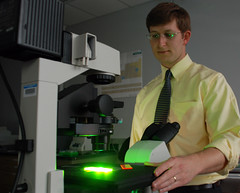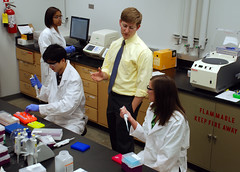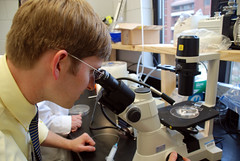Dr. Christopher Easley discusses his diabetes research
Published: 03/14/2011
By: Candis Birchfield , Carol Nelson
Diabetes is a disorder of the endocrine system signified by high levels of blood glucose resulting from defects in insulin production, insulin action, or both. According to the Centers for Disease Control and Prevention, or CDC, diabetes is the seventh leading cause of death in the U.S. and results in $174 billion in direct and indirect medical costs per year. Indeed, medical costs are more than two times greater for those with diabetes, due in part to a host of health problems that can result from the disease including: blindness and eye problems, kidney failure, limb amputation, heart disease, stroke, hypertension, pregnancy complications and depression.
The CDC estimates that diabetes affects 25.8 million people in the U.S., or more than eight percent of the population. Of those suffering from diabetes, about 1.9 million people age 20 or older were newly diagnosed in 2010. In the southeastern U.S. statistics are higher than the national average as more than 10 percent of the population has been diagnosed with diabetes.
To help combat the problem of diabetes in the U.S., Auburn University Assistant Professor of Chemistry Christopher Easley performs diabetes research in his lab in the College of Sciences and Mathematics, and works closely with the Boshell Diabetes and Metabolic Disease Research Program. The Boshell Diabetes and Metabolic Research Program is an interdisciplinary research group sponsored by the College of Veterinary Medicine.
"Part of why I decided to come to Auburn was because of the Boshell Diabetes Program," said Easley. "The program represents a collaborative effort throughout campus that strives to share knowledge and resources to benefit diabetes research."
Participants are represented from several colleges across campus including the College of Sciences and Mathematics, the College of Veterinary Medicine, the College of Human Sciences and the Harrison School of Pharmacy. In addition to a weekly journal club, members of the program also host a yearly conference that features leading researchers in the field of diabetes from around the U.S.
"This research program is very important, especially for the southeastern U.S., which is where I grew up and received my education," said Easley, who received his undergraduate degree in chemistry from Mississippi State, his Ph.D. in chemistry from the University of Virginia, and conducted post-doctoral research at Vanderbilt Medical Center.
"Having grown up in southwestern Mississippi where we drank sweet tea every single day, it doesn't really surprise me that diabetes is so prevalent in the Southeast. Of course, diabetes is not entirely related to diet. There are also genetic factors that result in diabetes, but right now, more than eight percent of the entire U.S. population has diabetes and that number is growing. In general, it's a disease of prosperity. You will find the highest percentages of diabetics in developed or developing countries."
Easley said he enjoys his research, not only because of the impact it can have on the lives of so many who suffer from diabetes, but also because the interdisciplinary nature of his work allows him to branch out beyond his primary field of study, chemistry.
Easley begins his research by engineering microfluidic devices. Microfluidic devices are created using a similar technological approach as the process used to make computer chips. However, instead of comprising tiny transistors like those found in a computer chip, a microfluidic device has a set of small channels that resemble miniature plumbing.
"These microfluidic devices give us the ability to study single cells or groups of cells and how they react with each other with different treatments," said Easley. "We focus on pancreatic islets and their relationship to diabetes. What makes pancreatic islets so useful and interesting is that they are aggregates of multiple cell types. A pancreatic islet is actually considered to be a ‘micro-organ' because it can function as an individual."
Easley uses microfluidic devices to study the "architecture" of pancreatic islets. Calling to mind his knowledge of biology, Easley then determines how many of each cell type are represented in an islet and examines the orientation of the cells. Easley will then apply his background in chemistry to determine how the structure and location of the cell types affect their function in terms of glucose stimulation after a meal. This post-meal simulation is made possible through the use of microfluidic devices, which hold nanoliters of volume, or billionths of a liter.
"Pancreatic islets are very important to diabetes research. Research shows that islets can be taken from a donor and transplanted to someone with type 1 diabetes, and the diabetes actually begins to reverse. But obviously diabetes is not yet cured," adds Easley. "This is a promising field that still has a lot of work to do, and we hope to make contributions by improving our understanding of islets as individuals."
For more information on Easley's research, visit his website at www.auburn.edu/cosam/easley. For more information on the Boshell Diabetes and Metabolic Disease Research Program visit the website atwww.vetmed.auburn.edu/boshell
More stories that may interest you
-
COSAM announces 2025 Academic Awards recipients: 3 from DMS
02/12/2025
-
DMS will host the Southeast Applied and Computational Math Student Workshop on April 5 - 6, 2025.
02/11/2025
-
DMS assistant professor Dr. Paul Zhang awarded the NSF CAREER Award
02/10/2025
-
DMS Applied Algebraic Geometry Conference to be held on April 19 and 20, 2025.
01/30/2025
-
DMS graduate students selected for awards this year for their hard work and excellence
12/03/2024
Latest Headlines
-
02/12/2025
-
02/11/2025
-
02/10/2025
-
01/30/2025
-
12/03/2024



